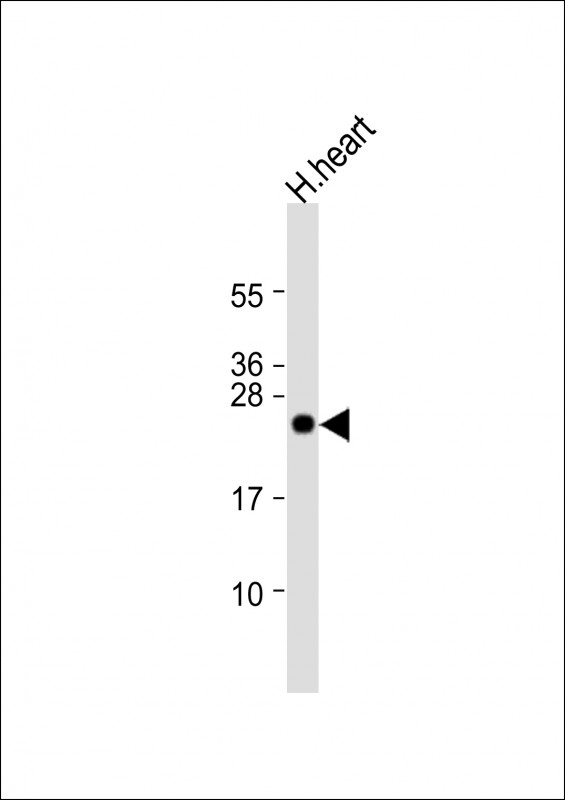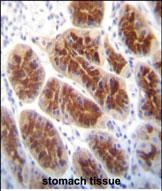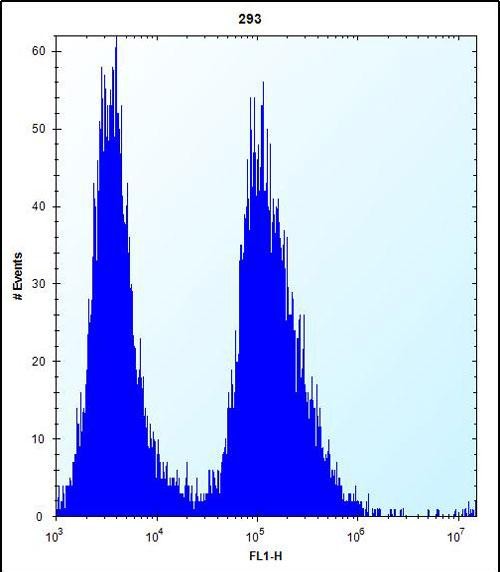CLDN2 Antibody (C-term Y224)
Affinity Purified Rabbit Polyclonal Antibody (Pab)
- SPECIFICATION
- CITATIONS
- PROTOCOLS
- BACKGROUND

Application
| FC, IHC-P, WB, E |
|---|---|
| Primary Accession | P57739 |
| Other Accession | NP_001164566.1, NP_001164563.1 |
| Reactivity | Human |
| Host | Rabbit |
| Clonality | Polyclonal |
| Isotype | Rabbit IgG |
| Calculated MW | 24549 Da |
| Antigen Region | 200-227 aa |
| Gene ID | 9075 |
|---|---|
| Other Names | Claudin-2, SP82, CLDN2 |
| Target/Specificity | This CLDN2 antibody is generated from rabbits immunized with a KLH conjugated synthetic peptide between 200-227 amino acids from the C-terminal region of human CLDN2. |
| Dilution | FC~~1:10~50 IHC-P~~1:10~50 WB~~1:1000 E~~Use at an assay dependent concentration. |
| Format | Purified polyclonal antibody supplied in PBS with 0.09% (W/V) sodium azide. This antibody is purified through a protein A column, followed by peptide affinity purification. |
| Storage | Maintain refrigerated at 2-8°C for up to 2 weeks. For long term storage store at -20°C in small aliquots to prevent freeze-thaw cycles. |
| Precautions | CLDN2 Antibody (C-term Y224) is for research use only and not for use in diagnostic or therapeutic procedures. |
| Name | CLDN2 {ECO:0000303|PubMed:31320686, ECO:0000312|HGNC:HGNC:2041} |
|---|---|
| Function | Forms paracellular channels: polymerizes in tight junction strands with cation- and water-selective channels through the strands, conveying epithelial permeability in a process known as paracellular tight junction permeability (PubMed:20460438, PubMed:36008380). In intestinal epithelium, allows for sodium and water fluxes from the peritoneal side to the lumen of the intestine to regulate nutrient absorption and clear enteric pathogens as part of mucosal immune response (By similarity). In kidney, allows passive sodium and calcium reabsorption across proximal tubules from the lumen back to the bloodstream (By similarity). In the hepatobiliary tract, allows paracellular water and cation fluxes in the hepatic perivenous areas and biliary epithelium to generate bile flow and maintain osmotic gradients (By similarity). |
| Cellular Location | Cell junction, tight junction. Cell membrane {ECO:0000250|UniProtKB:O88552}; Multi-pass membrane protein |

Thousands of laboratories across the world have published research that depended on the performance of antibodies from Abcepta to advance their research. Check out links to articles that cite our products in major peer-reviewed journals, organized by research category.
info@abcepta.com, and receive a free "I Love Antibodies" mug.
Provided below are standard protocols that you may find useful for product applications.
Background
This gene product belongs to the claudin protein family whose members have been identified as major integral membrane proteins localized exclusively at tight junctions. Claudins are expressed in an organ-specific manner and regulate tissue-specific physiologic properties of tight junctions. This protein is expressed in the intestine. Alternatively spliced transcript variants with different 5' untranslated region have been found for this gene.
References
Smith, A.J., et al. J. Acquir. Immune Defic. Syndr. 55(3):306-315(2010)
Kojima, F., et al. Oncol. Rep. 23(4):927-931(2010)
Szakal, D.N., et al. Virchows Arch. 456(3):245-250(2010)
Buchert, M., et al. Proc. Natl. Acad. Sci. U.S.A. 107(6):2628-2633(2010)
Mankertz, J., et al. Cell Tissue Res. 336(1):67-77(2009)
If you have used an Abcepta product and would like to share how it has performed, please click on the "Submit Review" button and provide the requested information. Our staff will examine and post your review and contact you if needed.
If you have any additional inquiries please email technical services at tech@abcepta.com.













 Foundational characteristics of cancer include proliferation, angiogenesis, migration, evasion of apoptosis, and cellular immortality. Find key markers for these cellular processes and antibodies to detect them.
Foundational characteristics of cancer include proliferation, angiogenesis, migration, evasion of apoptosis, and cellular immortality. Find key markers for these cellular processes and antibodies to detect them. The SUMOplot™ Analysis Program predicts and scores sumoylation sites in your protein. SUMOylation is a post-translational modification involved in various cellular processes, such as nuclear-cytosolic transport, transcriptional regulation, apoptosis, protein stability, response to stress, and progression through the cell cycle.
The SUMOplot™ Analysis Program predicts and scores sumoylation sites in your protein. SUMOylation is a post-translational modification involved in various cellular processes, such as nuclear-cytosolic transport, transcriptional regulation, apoptosis, protein stability, response to stress, and progression through the cell cycle. The Autophagy Receptor Motif Plotter predicts and scores autophagy receptor binding sites in your protein. Identifying proteins connected to this pathway is critical to understanding the role of autophagy in physiological as well as pathological processes such as development, differentiation, neurodegenerative diseases, stress, infection, and cancer.
The Autophagy Receptor Motif Plotter predicts and scores autophagy receptor binding sites in your protein. Identifying proteins connected to this pathway is critical to understanding the role of autophagy in physiological as well as pathological processes such as development, differentiation, neurodegenerative diseases, stress, infection, and cancer.





